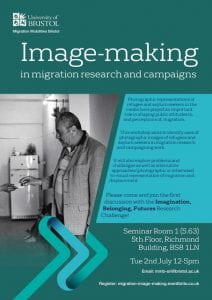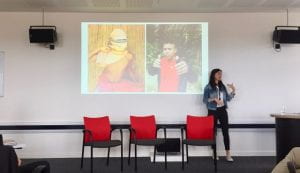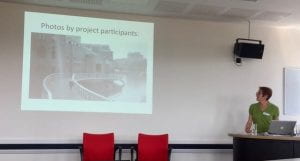By Nariman Massoumi
The first event of MMB’s Imagination, Belonging, Futures Research Challenge took place on Tuesday 2 July at the Department of Film and Television, University of Bristol.
Focusing on the topic of ‘image-making in migration research and campaigns’, the aim of the workshop was to consider the uses of photographic images of refugees and asylum seekers in migration research and campaigning work, exploring problems and challenges as well as alternative approaches (photographic or otherwise) to the visual representation of migration and displacement.
Around 30 people participated in the workshop including migration researchers and academics, representatives from campaigns and NGOs, filmmakers, photographers, artists and activists. The workshop was split into three sessions and the event was chaired by Bridget Anderson, MMB Director and Professor of Migration, Mobilities and Citizenship.

The first session consisted of panel presentations and discussion focusing particularly on ethical responsibilities, informed consent, collaborative and participatory practices and the processes involved in producing images. Camilla Morelli (Lecturer in Social Anthropology at the University of Bristol) presented her fascinating animated film about the imagination of marginalised Matses youth and their desires to live in the city. This film was part of her British Academy funded collaborative project Indigenous Animations, which brings together indigenous artists, animators and Amazonian children and youth to co-produce animated films. Through their participation in the research and visualisation processes, the participants’ consent and agency in their own representation was embedded into the outcomes.
Often the ‘people in the pictures’ – those whose images are used in campaigning material – are not consulted in how they are represented or what their opinions are on the subject. This was an issue passionately taken up by Jess Crombie, a humanitarian communications consultant and Lecturer in documentary image making and ethics at London College of Communication. Jess presented on research she conducted on the image-making of Save the Children and other NGOs. She stressed the importance of involving often unheard voices and views of those photographed in the image-making process (one of the recommendations of her report) alongside adopting creative and collaborative practices and sensitive communication that respect human dignity.
But collaborative practices can also become an additional source of stress and responsibility for those already dealing with the mental and physical trauma of fleeing persecution, being displaced and coping with hostile and restrictive asylum systems and policies, as Vicky Canning pointed out in her presentation on activism and resistance in refugee rights research. Canning called for a more direct, less ambiguous language in migration research and the system violence experienced by refugees, especially women. Vicky displayed her Asylum Navigation Board, which aims to help people understand the multiple barriers and restrictions facing those navigating the asylum system.
The second session turned towards presentations from the local community, beginning with a moving photo story by Bnar Sardar, an Iraqi Kurdish photojournalist living and studying Bristol. Titled Two Religions, One Roof, the photographic series offered an intimate portrait of belonging and co-habitation between two displaced families (one Christian and one Sunni) in Kirkurk. Bnar fled Iraqi Kurdistan in 1991 and is one of the only women to have documented the violence and displacement in the region.

Bnar recently took part in a community project in St. Pauls Darkrooms for refugee and asylum seekers – a short black and white photographic film course run by Ruth Jacobs from the Real Photography Company. Participants had the opportunity to take, develop and print photographs of Bristol. Ruth discussed the process involved and presented some of the images produced by the participants, which were exhibited at the Vestibules on College Green in June. The images presented a unique vision of the city through the poetic perspective of refugees.
St. Pauls Darkrooms is in the same building as Bristol Refugee Rights, a local asylum seeker and refugee support group. Ruth Soandro-Jones, Fundraising and Communications Manager for the organisation, followed with some important and candid reflections on the challenges of obtaining and using images of people seeking asylum while they are accessing support at BRR, especially in relation to fundraising requirements.
In the final session participants broke into groups to discuss a set of questions posed by organisers and raised by participants themselves in advance, and the issues discussed were brought together and categorised into key themes by Jacqueline Maingard (Reader in Film) in a short summary at the end.
The workshop had a dynamic, buzzing energy and a sense of urgency. A whole host of problems and challenges in the use of images in migration were brought forward and discussed. It appeared many participants were grappling with similar questions and challenges, despite coming from different sectors, perspectives and practices.
There was a desire amongst attendees to continue the discussion and consider the workshop as a launch for further activity and action. Watch this space!
Nariman Massoumi is the co-ordinator for the MMB Research Challenge, Imagination, Belonging, Futures.


1 thought on “Workshop on image-making in migration research and campaigns”
Comments are closed.